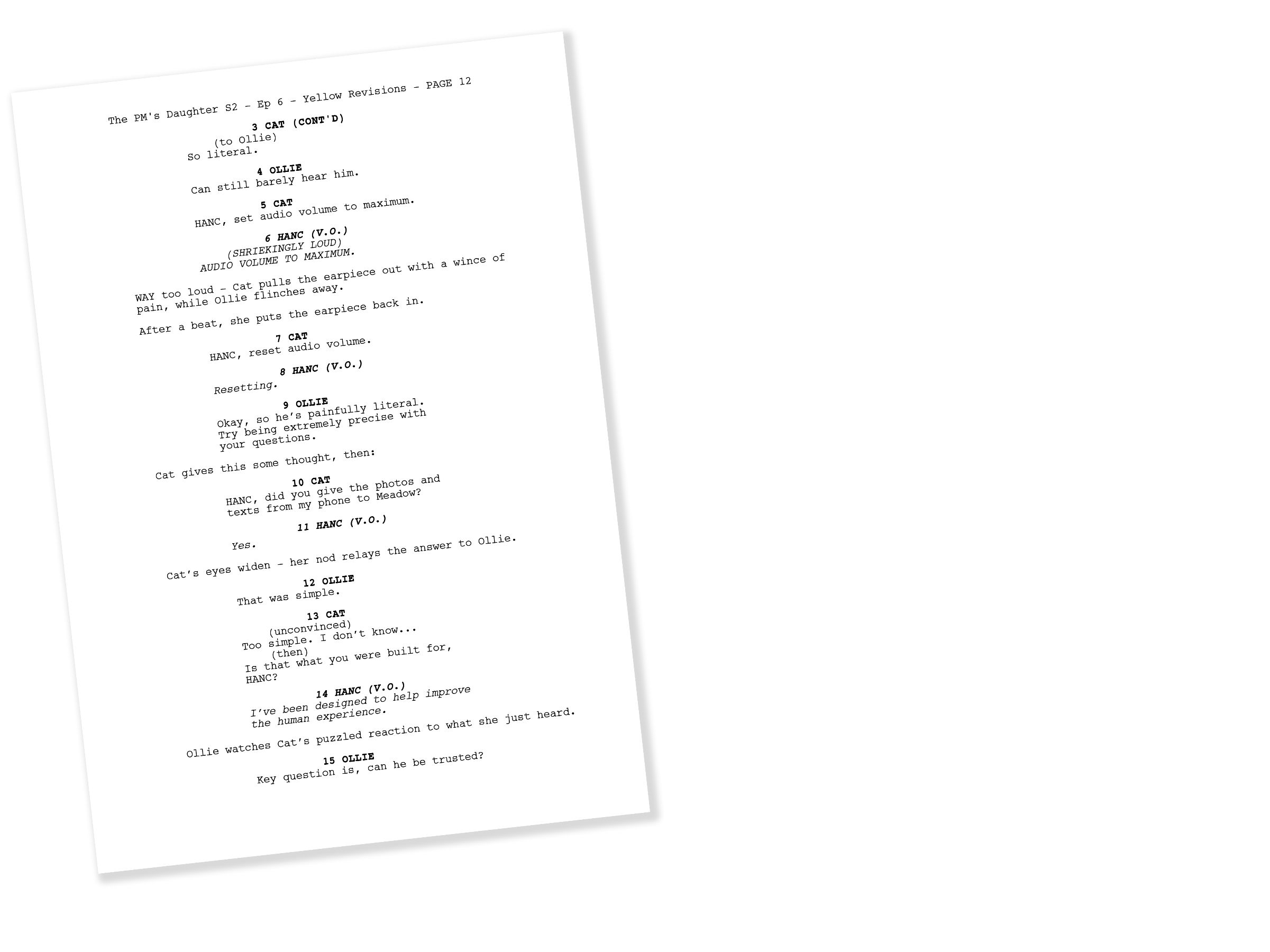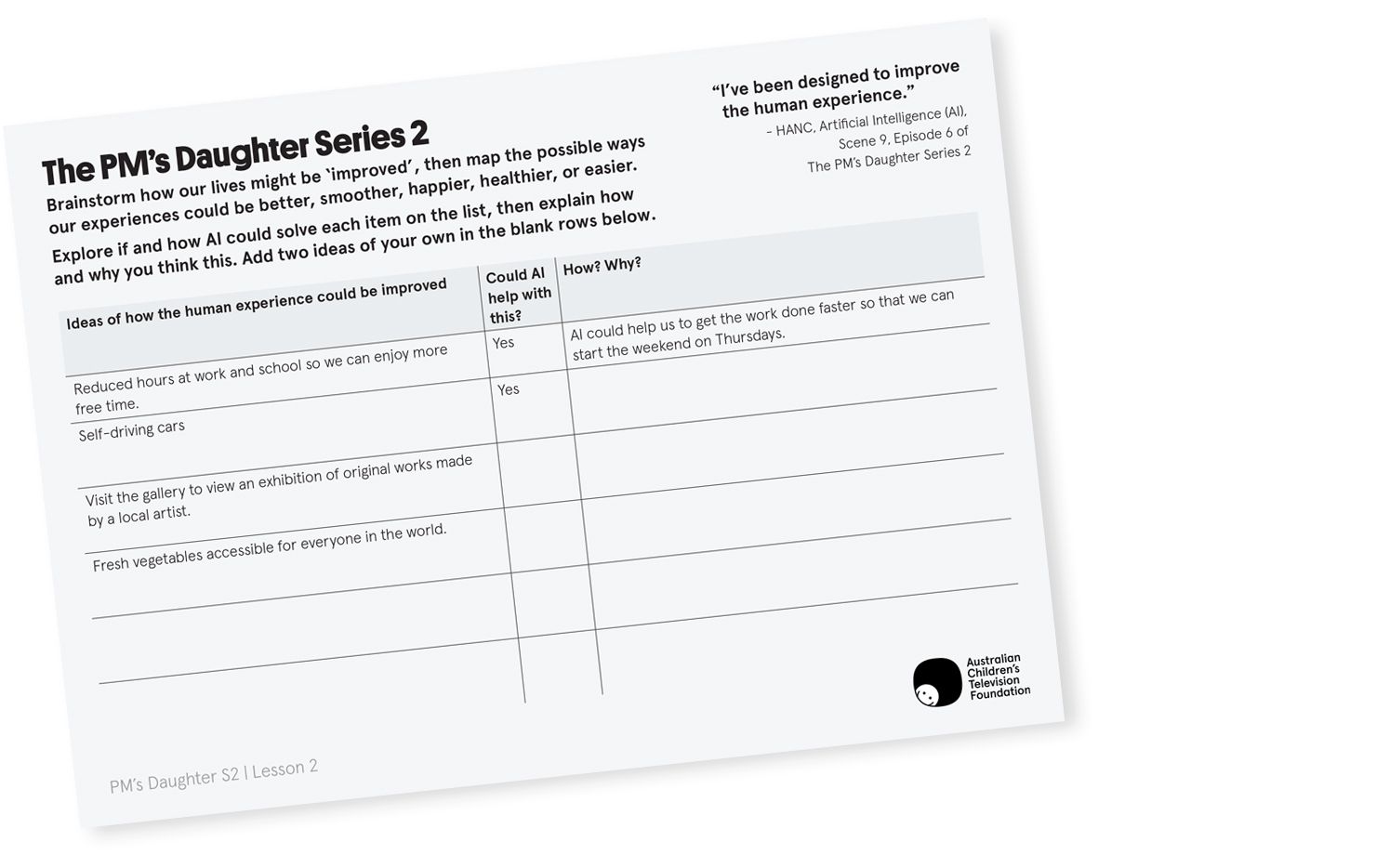Learning Intentions
- Analyse post-production scripts from a television series.
- Reflect and document how the human experience could be improved.
- Examine and document how AI could improve the human experience.
Learning Intentions

Review the script from scene 9, episode 6 of The PM’s Daughter. Highlight or circle elements of the story that interest you, anything that stands out as important, intriguing or note-worthy. Then, note your thinking or responses to these sections. For example, highlight a section of dialogue that seems like a prediction and then explain how the dialogue might be foreshadowing events for another scene.

Review the script excerpts and listen to the scene breakdown of scene 9, episode 6 of The PM’s Daughter Series 2.
Add notes to the script
Annotate the script while watching the video below (clip: 00.00 – 00:32) and the scene breakdown with script producer Jessica Paine (clip: 00:32 - 2:39).
As a writing task or in a class discussion, reflect on the statement:
“I’ve been designed to improve the human experience.” – HANC
Map how our lives might be ‘improved’, the ways our experience could be better, smoother, happier, healthier, or easier. Then, explore if and how AI could solve each item on the list.

|
|
Year 8 |
Years 9 |
Years 10 |
|
Analysis, evaluation and interpretation |
Locate, select and organise information, data and ideas from different sources. |
Locate, select and compare information, data and ideas from a range of sources. |
Analyse information, data and ideas about political, legal or civic issues to identify and evaluate differences in perspectives and interpretations. |
|
Civic participation and decision-making |
Explain the methods or strategies related to making decisions about civic participation. |
Evaluate the methods or strategies related to making decisions about civic participation. |
Evaluate the methods or strategies and outcomes related to making decisions about civic participation. |
|
|
Year 8 |
Year 9 |
Year 10 |
|
Language | Language for interacting with others |
Recognise how language shapes relationships and roles. |
Recognise how language empowers relationships and roles. |
Understand how language can have inclusive and exclusive social effects, and can empower or disempower people. |
|
Language | Text structure and organisation |
Explain how texts are structured depending on their purpose and how language features vary, recognising that some texts are hybrids that combine different genres or elements of different genres. Identify and use vocabulary typical of academic texts. |
Examine how authors adapt and subvert text structures and language features by experimenting with spoken, written, visual and multimodal elements, and their combination. Analyse how vocabulary choices contribute to style, mood and tone. |
Analyse text structures and language features and evaluate their effectiveness in achieving their purpose. Use an expanded technical and academic vocabulary for precision when writing academic texts. |
|
Literature | Engaging with and responding to literature |
Share opinions about the language features, literary devices and text structures that contribute to the styles of literary texts. |
Present a personal response to a literary text comparing initial impressions and subsequent analysis of the whole text. |
Analyse how the aesthetic qualities associated with text structures, language features, literary devices and visual features, and the context in which these texts are experienced, influence audience response. |
|
Literature | Examining literature |
Analyse how language features such as sentence patterns create tone, and literary devices such as imagery create meaning and effect. |
Analyse texts and evaluate the aesthetic qualities and appeal of an author’s literary style. |
Analyse how text structure, language features, literary devices and intertextual connections shape interpretations of texts. |
|
Literature | Creating literature |
Create and edit literary texts that experiment with language features and literary devices for particular purposes and effects. |
Create and edit literary texts, that may be a hybrid, that experiment with text structures, language features and literary devices for purposes and audiences. |
Compare and evaluate how “voice” as a literary device is used in different types of texts, such as poetry, novels and film, to evoke emotional responses. |
|
Literacy | Texts in context |
Identify how texts reflect contexts. |
Analyse how representations of people, places, events and concepts reflect contexts. |
Analyse and evaluate how people, places, events and concepts are represented in texts and reflect contexts. |
|
Literacy | Analysing, interpreting and evaluating |
Analyse and evaluate the ways that language features vary according to the purpose and audience of the text, and the ways that sources and quotations are used in a text. Use comprehension strategies such as visualising, predicting, connecting, summarising, monitoring, questioning and inferring to interpret and evaluate ideas in texts. |
Analyse and evaluate how language features are used to represent a perspective of an issue, event, situation, individual or group. Use comprehension strategies such as visualising, predicting, connecting, summarising, monitoring, questioning and inferring to compare and contrast ideas and opinions in and between texts. |
Listen to spoken texts and explain the purposes and effects of text structures and language features, and use interaction skills to discuss and present an opinion about these texts. Analyse and evaluate how language features are used to implicitly or explicitly represent values, beliefs and attitudes. |
|
|
Year 8 |
Year 9 |
Year 10 |
|
Inquiring - Identify, process and evaluate information |
Identify and clarify significant information and opinion from a range of sources, including visual information and digital sources. |
|
|
|
Reflecting - Think about thinking (metacognition) |
Reflect on the thinking and processes used when completing activities or drawing conclusions. |
Reflect on the thinking and processes used when completing activities and drawing conclusions. |
|
|
Inquiring - Identify, process and evaluate information |
|
Identify and clarify significant information and opinion from a range of sources, including visual information and digital sources. |
|
|
Reflecting - Transfer knowledge |
Transfer knowledge and skills gained in previous experiences to both similar and different contexts, and explain reasons for decisions and choices made. |
Identify, plan and justify opportunities to transfer knowledge into new contexts. |
|
|
Analysing - Draw conclusions and provide reasons |
Draw conclusions and make choices when completing tasks by connecting evidence from within and across discipline areas to provide reasons and evaluate arguments for choices made. |
|
|
|
|
Year 8 |
Year 9 |
Year 10 |
|
Explain how different traits, such as honesty, trust, courage and selfishness interact with responsibilities or duties to determine ethically appropriate responses. |
Explore and analyse examples of the tensions between conflicting positions on issues of personal, social and global importance. |
|
|